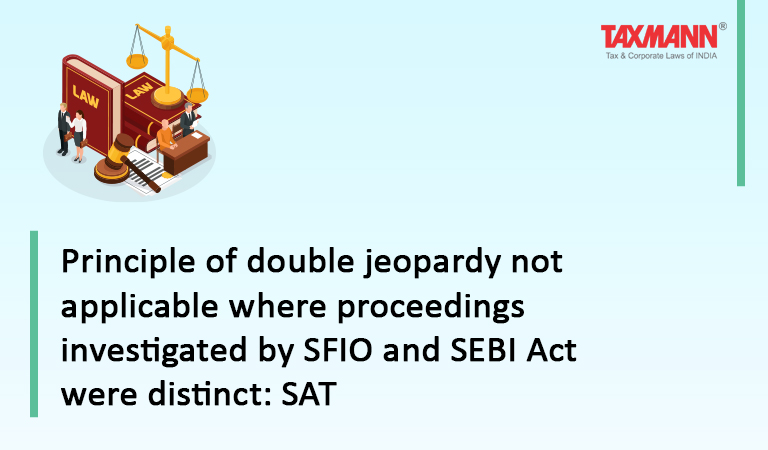Principle of double jeopardy not applicable where proceedings investigated by SFIO and SEBI Act were distinct: SAT
- Blog|News|Company Law|
- 2 Min Read
- By Taxmann
- |
- Last Updated on 4 March, 2022
Case details: Seashore Securities Ltd. v. Securities and Exchange Board of India - [2021] 128 taxmann.com 301 (SAT - Mumbai)
Judiciary and Counsel Details
-
- Justice Tarun Agarwal, Presiding Officier and M.T Joshi, Judicial Member
- Nimay Dave, Ankur Loona, Ms. Aparna Wagle and Yash Garach, Advs. for the Appellant.
-
Pradeep Sancheti, Sr. Adv., Anubhav Ghosh and Ravishekhar Pandey, Advs. for the Respondent.
Facts of the Case
In the given case, the Company under investigation had issued Redeemable Preference Shares (RPS) to allottees from 2008-09 to 2012-13 and had raised an amount of approximately Rs. 503 crore in violation of SEBI Act, 1992 and Companies Act.
Accordingly, an order was passed by a Whole-time member, SEBI holding that company came out with an offer that was violative of sections 56 and 73 of the Companies Act, and accordingly, certain directions were issued to appellants to refund monies so collected during their period of directorship along with interest and they were restrained from selling their assets and were further restrained from accessing securities market, etc.
However, the Appellants contended that Serious Fraud Investigation Office (SFIO) was looking into the complaint under section 212(2) of the Companies Act and therefore no proceedings could have been initiated by SEBI.
SAT Held
It was alleged that it was a case of double jeopardy and that two different proceedings could not be initiated for the same cause of action. However, it was found that two proceedings investigated by SFIO under section 212(2) of the Companies Act and proceedings initiated by SEBI were distinct and cause of action was also not the same, and, in any case, the principle of double jeopardy was not applicable in the instant case.
Furthermore, it was also found that section 212(2) relates to a bar on other investigating agencies and in the instant case, SEBI was a Regulator and was not an investigating agency, thus the contention raised had no basis. Therefore, there being no error in the impugned order passed by WTM, SEBI, the appeal was to be dismissed.
Disclaimer: The content/information published on the website is only for general information of the user and shall not be construed as legal advice. While the Taxmann has exercised reasonable efforts to ensure the veracity of information/content published, Taxmann shall be under no liability in any manner whatsoever for incorrect information, if any.

Taxmann Publications has a dedicated in-house Research & Editorial Team. This team consists of a team of Chartered Accountants, Company Secretaries, and Lawyers. This team works under the guidance and supervision of editor-in-chief Mr Rakesh Bhargava.
The Research and Editorial Team is responsible for developing reliable and accurate content for the readers. The team follows the six-sigma approach to achieve the benchmark of zero error in its publications and research platforms. The team ensures that the following publication guidelines are thoroughly followed while developing the content:
- The statutory material is obtained only from the authorized and reliable sources
- All the latest developments in the judicial and legislative fields are covered
- Prepare the analytical write-ups on current, controversial, and important issues to help the readers to understand the concept and its implications
- Every content published by Taxmann is complete, accurate and lucid
- All evidence-based statements are supported with proper reference to Section, Circular No., Notification No. or citations
- The golden rules of grammar, style and consistency are thoroughly followed
- Font and size that’s easy to read and remain consistent across all imprint and digital publications are applied








 CA | CS | CMA
CA | CS | CMA


